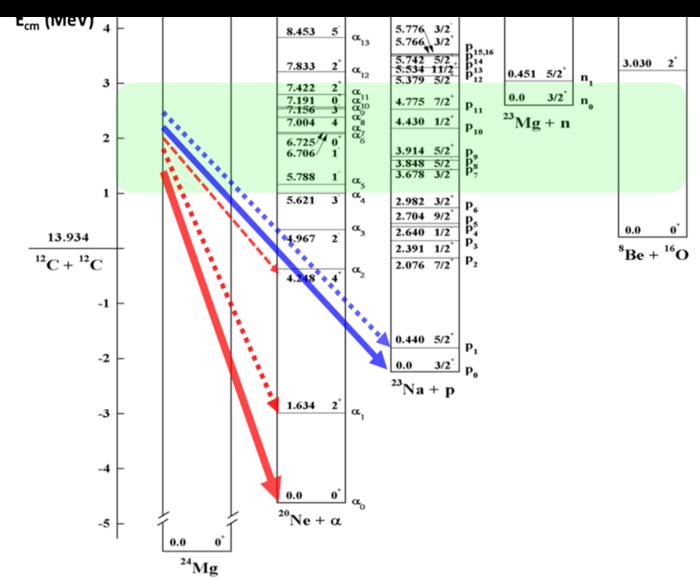A team of researchers from the Institute of Modern Physics and Sichuan University has recently achieved a groundbreaking milestone in nuclear astrophysics by performing the most sensitive direct measurement of the fusion reaction between two carbon-12 (^12C) nuclei at energies relevant to stellar interiors. Utilizing the advanced LEAF accelerator facility, the scientists conducted their experiment at an exceptionally low center-of-mass energy of 2.22 MeV, well within the elusive astrophysical Gamow window—an energy range critical to understanding the nuclear processes that fuel stars and supernova explosions.
The fusion of two carbon-12 nuclei, symbolized as ^12C+^12C, plays a pivotal role in the late evolutionary stages of massive stars and in explosive astrophysical phenomena, including Type Ia supernovae and X-ray bursts. These reactions occur at energies notably below the Coulomb barrier, a repulsive electrostatic energy peak of approximately 5.8 MeV due to the positively charged nuclei. Such sub-barrier energies severely suppress the reaction cross section, thereby making direct experimental detection extraordinarily challenging. Astrophysicists have long sought to pin down the precise fusion rates at these conditions to improve the fidelity of stellar models.
In this pioneering study, the researchers employed a high-intensity, doubly ionized carbon beam (^12C^2+) directed onto a target made of highly oriented pyrolytic graphite (HOPG), a material chosen for its remarkable purity and ultra-low background interference, thereby enhancing the sensitivity of the measurement. The innovative detection system combined a Time Projection Chamber (TPC) with a silicon-strip detector array, configured as a ΔE–E telescope. This sophisticated apparatus enabled the real-time tracking and identification of charged particles emitted during the fusion process, providing exquisite discrimination between alpha particles, protons, and background signals.
One of the key channels probed was the ground-state alpha emission, described by the reaction ^12C(^12C,α_0)^20Ne, where the fused magnesium-24 (^24Mg*) compound nucleus decays by emitting an alpha particle, producing neon-20 (^20Ne). The experiment recorded a thick-target yield on the stunningly low order of 10^−17 alpha particles per incident carbon ion, a sensitivity unattained by any previous study. The derived cross section at 2.22 MeV center-of-mass energy resides in the picobarn regime or below, aligning with theoretical predictions for fusion under such deep sub-barrier conditions.
This experimental achievement not only provides essential data for astrophysical models but also showcases the formidable technical challenges inherent in probing fusion reactions at ultra-low energies. The intense beam flux required to compensate for the negligible cross sections induced significant radiation damage to the HOPG target surface. Remarkably, after an accumulated beam dose of approximately 5 coulombs, the team observed a drastic reduction in fusion yields: the alpha particle signal declined by roughly 51%, while the proton emission channel suffered a 25% decrease. Such degradation underscores the delicate balance between acquiring sufficient reaction statistics and preserving target integrity during prolonged irradiation.
The radiation damage manifested as alterations in the physical and chemical properties of the HOPG surface, including a reduction in hydrogen content, contributing to the deterioration of fusion yields over time. These effects necessitated careful correction procedures to reliably interpret the measured data and to provide accurate reaction cross sections. The findings emphasize the complexity of conducting direct measurements at astrophysically relevant energies and highlight the importance of continued improvements in target technology and beam delivery systems.
Beyond experimental implications, the results bear profound significance for astrophysics. The ^12C+^12C fusion reaction rate is a cornerstone parameter dictating the conditions under which carbon ignition occurs inside massive stars, ultimately influencing their fate—whether they evolve into neutron stars, black holes, or trigger supernova explosions. Precise knowledge of these reaction cross sections at stellar energies refines nucleosynthesis predictions and enhances our understanding of the elemental abundances observed in the universe.
The experimental methodology employed sets a new standard for sensitivity in nuclear astrophysics research. The integration of the Time Projection Chamber and silicon detectors through a ΔE–E telescope arrangement allowed for robust particle identification and background suppression, overcoming one of the greatest hurdles in measuring rare fusion events amid spurious signals. This approach exemplifies how state-of-the-art detector technology can unlock previously inaccessible regions of the nuclear reaction landscape.
Despite the successes, the researchers acknowledge the necessity for future advancements to mitigate radiation-induced target degradation, which constrains measurement duration and data quality at these faint reaction rates. Potential directions include the development of novel target materials with enhanced resistance to damage and beam-induced modifications. Additionally, increased beam intensities and refined detection techniques promise to push the envelope of measurable fusion cross sections even closer to the conditions found in stellar plasmas.
The discovery detailed here bridges a critical gap in experimental nuclear astrophysics by furnishing benchmark data directly within the astrophysical Gamow window for the ^12C+^12C system. These results will undoubtedly fuel theoretical efforts to model stellar carbon burning with unprecedented accuracy and stimulate further experimental investigations targeting other key fusion reactions integral to stellar evolution and explosive astrophysical phenomena.
This monumental effort culminates in a publication appearing in the journal Nuclear Science and Techniques, where the full breadth of experimental data, analysis methodologies, and theoretical context are meticulously presented. The study represents a landmark in the quest to decipher the nuclear reactions governing the life cycles of stars and the cosmic synthesis of elements.
Subject of Research: Not applicable
Article Title: 12C+12C fusion reaction at astrophysical energies using HOPG target
News Publication Date: 4-Jun-2025
Web References: https://doi.org/10.1007/s41365-025-01714-3
References: DOI: 10.1007/s41365-025-01714-3
Image Credits: Shuo Wang
Keywords
Astrophysics, Radiation, Energy, Nuclear reactions




